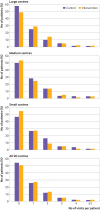Remote, proactive, telephone based management of toxicity in outpatients during adjuvant or neoadjuvant chemotherapy for early stage breast cancer: pragmatic, cluster randomised trial
- PMID: 34880055
- PMCID: PMC8652580
- DOI: 10.1136/bmj-2021-066588
Remote, proactive, telephone based management of toxicity in outpatients during adjuvant or neoadjuvant chemotherapy for early stage breast cancer: pragmatic, cluster randomised trial
Abstract
Objective: To evaluate the effectiveness of remote proactive management of toxicities during chemotherapy for early stage breast cancer.
Design: Pragmatic, cluster randomised trial.
Setting: 20 cancer centres in Ontario, Canada, allocated by covariate constrained randomisation to remote management of toxicities or routine care.
Participants: All patients starting adjuvant or neoadjuvant chemotherapy for early stage breast cancer at each centre. 25 patients from each centre completed patient reported outcome questionnaires.
Interventions: Proactive, standardised, nurse led telephone management of common toxicities at two time points after each chemotherapy cycle.
Main outcome measures: The primary outcome, cluster level mean number of visits to the emergency department or admissions to hospital per patient during the whole course of chemotherapy treatment, was evaluated with routinely available administrative healthcare data. Secondary patient reported outcomes included toxicity, self-efficacy, and quality of life.
Results: Baseline characteristics of participants were similar in the intervention (n=944) and control arms (n=1214); 22% were older than 65 years. Penetration (that is, the percentage of patients who received the intervention at each centre) was 50-86%. Mean number of visits to the emergency department or admissions to hospital per patient was 0.91 (standard deviation 0.28) in the intervention arm and 0.94 (0.40) in the control arm (P=0.94); 47% (1014 of 2158 patients) had at least one visit to the emergency department or a hospital admission during chemotherapy. Among 580 participants who completed the patient reported outcome questionnaires, at least one grade 3 toxicity was reported by 48% (134 of 278 patients) in the intervention arm and by 58% (163 of 283) in the control arm. No differences in self-efficacy, anxiety, or depression were found. Compared with baseline, the functional assessment of cancer therapy trial outcome index decreased by 6.1 and 9.0 points in the intervention and control participants, respectively.
Conclusions: Proactive, telephone based management of toxicities during chemotherapy did not result in fewer visits to the emergency department or hospital admissions. With the rapid rise in remote care because of the covid-19 pandemic, identifying scalable strategies for remote management of patients during cancer treatment is particularly relevant.
Trial registration: ClinicalTrials.gov NCT02485678.
© Author(s) (or their employer(s)) 2019. Re-use permitted under CC BY-NC. No commercial re-use. See rights and permissions. Published by BMJ.
Conflict of interest statement
Competing interests: All authors have completed the ICMJE uniform disclosure form at www.icmje.org/disclosure-of-interest/ and declare: support from the Ontario Institute for Cancer Research (OICR) for the submitted work; no financial relationships with any organisations that might have an interest in the submitted work in the previous three years; CCE and EG hold appointments at the OICR Health Services Research Programme; no other relationships or activities that could appear to have influenced the submitted work.
Figures
References
-
- Eskander A, Krzyzanowska MK, Fischer HD, et al. . Emergency department visits and unplanned hospitalizations in the treatment period for head and neck cancer patients treated with curative intent: A population-based analysis. Oral Oncol 2018;83:107-14. 10.1016/j.oraloncology.2018.06.011 - DOI - PubMed
Publication types
MeSH terms
Associated data
LinkOut - more resources
Full Text Sources
Medical


